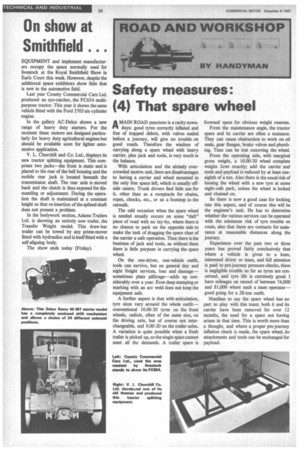Safety measures: (4) That spare wheel
Page 40

If you've noticed an error in this article please click here to report it so we can fix it.
AMAIN ROAD puncture is a rarity nowadays: good tyres correctly inflated and free of trapped debris, with valves sealed before a journey, will give no trouble on good roads. Therefore the wisdom of carrying along a spare wheel with heavy carrier, plus jack and tools, is very much in the balance.
With articulation and the already overcrowded motive unit, there are disadvantages to having a carrier and wheel mounted in the only free space left, which is usually offside centre. Trunk drivers find little use for it, other than as a receptacle for chains, ropes, chocks, etc., or as a footstep to the catwalk.
The odd occasion when the spare wheel is needed usually occurs on some "daft" piece of road with no lay-by, where there is no chance to park on the opposite side to make the task of dragging the spare clear of the carrier a safe operation. Then there is the business of jack and tools, as without them there is little purpose in carrying the spare wheel.
On the one-driver, one-vehicle outfit, tools can survive, but on general day and night freight services, loss and damage— sometimes plain pilferage—adds up considerably over a year. Even deep stamping or marking with an arc weld does not keep the equipment safe.
A further aspect is that with articulation, tyre sizes vary around the whole outfit— conventional 10.00-20 tyres on the front wheels, radials, often of the same size, on the driving axle, but of course not interchangeable, and 9.00-20 on the trailer axles. A variation is quite possible when a fresh trailer is picked up, so the single spare cannot meet all the demands. A trailer spare is frowned upon for obvious weight reasons.
From the maintenance angle, the tractor spare and its carrier are often a nuisance.
They can cause obstruction to work on oil seals, gear flanges, brake valves and plumbing. Time can be lost removing the wheel. From the operating side, with marginal gross weight, a 10.00-20 wheel complete weighs 2cwt exactly; add the carrier and tools and payload is reduced by at least oneeighth of a ton. Also there is the usual risk of loosing the wheel with a new tyre at some night-cafe park, unless the wheel is locked and chained on_ So there is now a good case for looking into this aspect, and of course this will be the engineer's task. He has to determine whether the various services can be operated with the minimum risk of tyre trouble en route, also that there are contacts for assistance at reasonable distances along the journey.
Experience over the past two or three years has proved fairly conclusively that where a vehicle is given to a keen, interested driver or team, and full attention is paid to pre-journey pressure checks, there is negligible trouble so far as tyres are concerned, and tyre life is extremely good. I have mileages on record of between 74,000 and 81,000 where such a team operates— good going for a 28-ton outfit.
Needless to say the spare wheel has no part to play with this team; both it and its carrier have been removed for over 12 months, the need for a spare not having arisen in that time. This is worth more than a thought, and where a proper pre-journey inflation check is made, the spare wheel, its attachments and tools can be exchanged for payload.








































































































